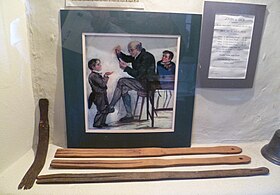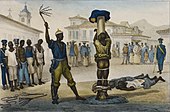Tawse

| Part of a series on |
| Corporal punishment |
|---|
 |
| By place |
| By implementation |
| By country |
| Court cases |
| Politics |
| Campaigns against corporal punishment |
The tawse, sometimes formerly spelled taws (the plural of Scots taw, a thong of a whip), is an implement used for corporal punishment. It was used for educational discipline, primarily in Scotland, but also in schools in a few English cities e.g. Newcastle upon Tyne, Gateshead, Liverpool, Manchester and Walsall.
A tawse consists of a strip of leather, with one end split into a number of tails. The thickness of the leather and the number of tails is variable. Many Scottish makers of horse tack made tawses for local schoolmasters. The official name "tawse" was hardly ever used in conversation by either teachers or pupils, who instead referred to it as either the school strap or the belt, the normal term for an unforked implement, as worn in trousers (see belt).
Schools
[edit]Scottish state (public) schools used the tawse to punish pupils of either sex on the palm of the outstretched hand. Pupils were usually instructed to hold out one hand, palm uppermost, supported by the other hand below, which made it difficult to move the hand away during the infliction of the strokes. It also ensured that the full force of each stroke was taken by the hand being strapped. The punishment was usually inflicted by the class teacher in front of the entire class, to act as a deterrent to others; sometimes by a designated teacher, such as the Deputy Headmaster, to whom the pupil was sent.
This was wielded in primary as well as secondary schools for both trivial and serious offences, and girls got belted as well as boys.[1] Nearly 6 in 10 girls were strapped in school.[citation needed]
In Walsall and Gateshead, and in some schools in Manchester and Nottingham, students (mainly male) were tawsed on the seat of the trousers.
Some Scottish private (independent) schools also used the tawse, such as Keil School. St Aloysius' College, Glasgow used the ferula, a thin strip of metal covered in rubber, but others such as Fettes College used the cane instead, as did most schools in England outside the north-east.
In 1982, two Scottish mothers went to the European Court of Human Rights, who passed a judgment that parents had the right to refuse corporal punishment of a child.[2] This judgement led indirectly to the use of the tawse (and all other forms of corporal punishment) being banned by law in UK state schools. The legislation came into force in 1987, but most Scottish local education authorities had already abolished it by the early 1980s.
John J. Dick Leather Goods was a manufacturer in Lochgelly estimated to have made around 70% of tawses when they were used in schools.[3][4] Original tawses sold for around £6 in 1982 but twenty years later, some collectors were paying hundreds of pounds each for rare items.[5]
Judicial
[edit]The tawse was also used for judicial corporal punishment in Scotland as an alternative to the more usual birch. Courts could sentence boys of over 14 but under 16 to up to 36 strokes with an extra-heavy tawse for any offence. This was administered to the offender's bare buttocks. Judicial corporal punishment was abolished in 1948.
See also
[edit]References
[edit]- ^ "Scottish Review: Carol Craig". www.scottishreview.net. Retrieved 17 March 2020.
- ^ Linklater, John (26 February 1982). "Victor in belt case set to sue". The Glasgow Herald. p. 1. Archived from the original on 23 March 2022. Retrieved 28 January 2017.
- ^ "How the tawse left its mark on Scottish pupils". BBC News. 22 February 2017. Retrieved 13 March 2017.
- ^ Making the Lochgelly Tawse. BBC. 20 February 2017. Retrieved 13 March 2017.
- ^ "Cash-strapped teachers offer shy collectors six of the best". The Scotsman. Edinburgh. 25 August 2002. Retrieved 13 March 2016.
Sources and external links
[edit]- The Cane and the Tawse in Scottish Schools, article at World Corporal Punishment Research
- "The Belt (Factsheet 12)" (PDF). Heatherbank Museum of Social Work. Glasgow: Glasgow Caledonian University. Archived from the original (PDF) on 1 June 2010. Retrieved 16 July 2017.
- The True History of the Lochgelly Tawse
